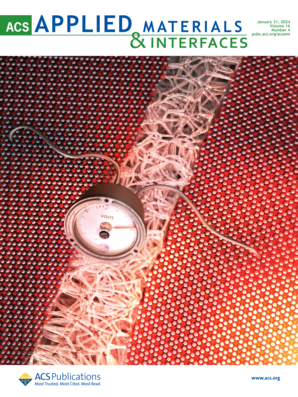Energy-Saving VO2 Bilayer Films with Self-Cleaning and Self-Healing for Smart Windows
IF 8.3
2区 材料科学
Q1 MATERIALS SCIENCE, MULTIDISCIPLINARY
引用次数: 0
Abstract
Thermochromic VO2 has garnered widespread attention with unique optical regulation in the fields of smart windows. However, VO2 windows with persistent stability and optical tunability in an outdoor environment are still a challenge. This study presents a multifunctional VO2 film, including a thermochromic VO2/polymer layer with VO2 particles dispersed in a urea-polydimethylsiloxane (uPDMS) matrix and a smooth liquid-infused porous surface (SLIPS) layer with silicone oil filling in porous structures. Entrapping VO2 particles within the urea-polydimethylsiloxane net ensures thermochromic stability. The extensive hydrogen bonds between urea groups and highly mobile polydimethylsiloxane chains ensure the self-healing performance, while the upper SLIPS layer offers the self-cleaning performance. This bilayer composite film demonstrates excellent solar modulation ability (ΔTsol = 20.25%), adequate visible light transmittance (Tlum,c = 47.78%), a remarkable self-cleaning performance (RA = 8.9°), and notable self-healing abilities (healing rate = 88.48%). The research herein offers a reliable approach for fabricating stable smart energy-saving window films.

智能窗户的自清洁自修复节能VO2双层膜
热致变色VO2以其独特的光调节特性在智能窗领域引起了广泛的关注。然而,在室外环境中具有持久稳定性和光学可调性的VO2窗口仍然是一个挑战。本研究提出了一种多功能VO2薄膜,包括一个热致变色VO2/聚合物层,其中VO2颗粒分散在尿素-聚二甲基硅氧烷(uPDMS)基质中,以及一个光滑的液体注入多孔表面(SLIPS)层,其中硅油填充在多孔结构中。在尿素-聚二甲基硅氧烷网中捕获VO2颗粒可确保热致变色稳定性。尿素基团之间广泛的氢键和高流动性的聚二甲基硅氧烷链确保了自修复性能,而上层的slip层提供了自清洁性能。该双层复合膜具有优异的太阳调制能力(ΔTsol = 20.25%)、充足的可见光透过率(Tlum,c = 47.78%)、显著的自清洁性能(RA = 8.9°)和显著的自修复能力(愈合率= 88.48%)。本文的研究为制造稳定的智能节能窗膜提供了一条可靠的途径。
本文章由计算机程序翻译,如有差异,请以英文原文为准。
求助全文
约1分钟内获得全文
求助全文
来源期刊

ACS Applied Materials & Interfaces
工程技术-材料科学:综合
CiteScore
16.00
自引率
6.30%
发文量
4978
审稿时长
1.8 months
期刊介绍:
ACS Applied Materials & Interfaces is a leading interdisciplinary journal that brings together chemists, engineers, physicists, and biologists to explore the development and utilization of newly-discovered materials and interfacial processes for specific applications. Our journal has experienced remarkable growth since its establishment in 2009, both in terms of the number of articles published and the impact of the research showcased. We are proud to foster a truly global community, with the majority of published articles originating from outside the United States, reflecting the rapid growth of applied research worldwide.
 求助内容:
求助内容: 应助结果提醒方式:
应助结果提醒方式:


